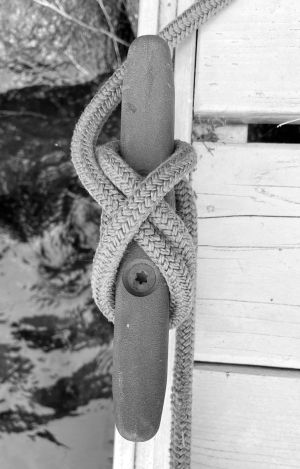
Boat Knots and Dockin’

If you are around boats, either as an owner or a guest, rope (lines) and knots are important. Many of our readers have boats on these inland lakes, and from what I’ve seen — many have not learned how to tie their boat to a dock in a secure but simple fashion. I see concoctions of knots that may or may not be secure, but sure are worth a good chuckle. People mean well but have never been shown or told how to tie a boat in a proper fashion.
Here are a few hints to get you headed in the right direction. Mastering any or all of the below suggestions can make boating much easier and less stressful.
There are three or four basic knots that can work nicely and are really all you need. Which one(s) you use depends on the situation you are confronted with at different docks, and whether your tie-up is for a short time or a long period.
When approaching a dock of any sort, peruse from a short distance out what there is to tie to. You may see cleats with double ears that require a figure eight looping and a final loop over one end. You may see a ring that requires threading the end of an open line then going back to your boat or tying to your own line.
A not uncommon third situation is a post sticking up which requires a quick but secure double loop dropped over the top. This is known as two half hitches or a clove hitch — my favorite for quick and easy.
Some other common knots that are helpful in different ways are: a figure eight knot, a.k.a. a stopper knot (used to put a knot in the end of a line so that it won’t fray or go back through a pulley/shiv; a bowline, for making a loop which is secure and can always be untied easily no matter the load (towing a boat is a good example). One last suggestion is a square knot, a.k.a. a reef knot, used to tie two lines together of different or like diameters.
Now let’s talk about docking. Most people don’t drive a boat enough to get really good at it, but here’s a few hints to work on:
Assess the situation from a few boat lengths away. Are there obstacles such as a mooring line, anchored or docked boats, shallow water? What is the wind direction and current (if any of either). Once you’ve done that, make your landing plan, but base it (if possible) landing into the wind. Ready your lines and fenders, alert your mate with instruction and share your plan. You always want the nose of your boat to go into the wind or current when landing. You have much more control with steering and power and can put the nose of your boat right where you want it, where a mate can step off with a line and secure your bow. Once that is done, if needed, you can reverse your engine with low r.p.m. and swing the stern towards the dock, pivoting on the secured front line.
Practice and you will become better as time goes on, if you are a beginner, use a floating boat fender or marker buoy in open water before attempting a dock. I hope you find this helpful! I’ve been doing this for 70 years and still goof now and then.
Rod Johnson was born and raised in the Belgrade Lakes in the 1950s and ’60s.
Download Full Newspaper: High Res | Low Res (Details…)
<— Previous Article • Summaries • Next Article —>
©2022 by Summertime in the Belgrades. All rights reserved.